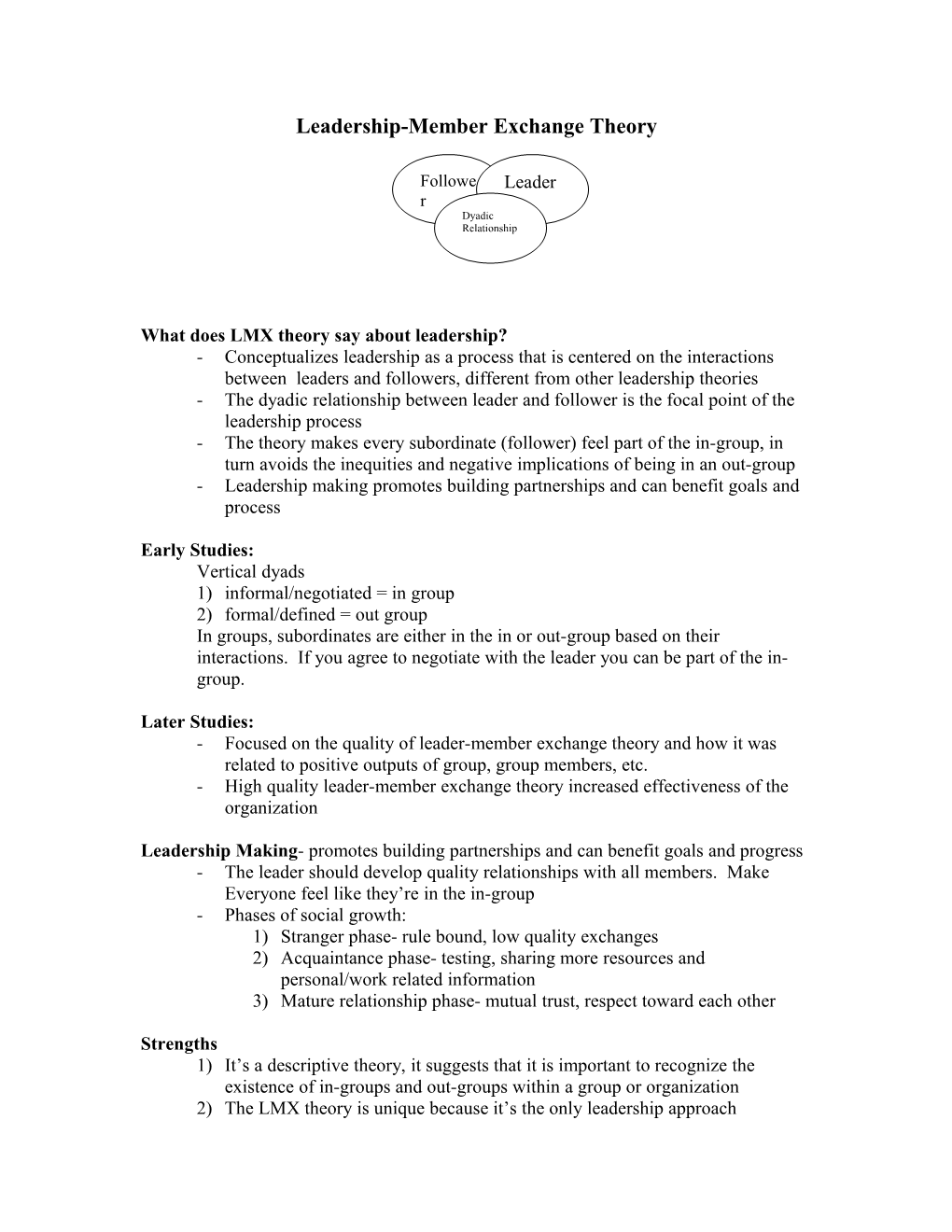Leadership-Member Exchange Theory
What does LMX theory say about leadership?
-Conceptualizes leadership as a process that is centered on the interactions
between leaders and followers, different from other leadership theories
-The dyadic relationship between leader and follower is the focal point of the
leadership process
-The theory makes every subordinate (follower) feel part of the in-group, in
turn avoids the inequities and negative implications of being in an out-group
-Leadership making promotes building partnerships and can benefit goals and
process
Early Studies:
Vertical dyads
1)informal/negotiated = in group
2)formal/defined = out group
In groups, subordinates are either in the in or out-group based on their interactions. If you agree to negotiate with the leader you can be part of the in-group.
Later Studies:
-Focused on the quality of leader-member exchange theory and how it was
related to positive outputs of group, group members, etc.
-High quality leader-member exchange theory increased effectiveness of the
organization
Leadership Making- promotes building partnerships and can benefit goals and progress
-The leader should develop quality relationships with all members. Make
Everyone feel like they’re in the in-group
-Phases of social growth:
1)Stranger phase- rule bound, low quality exchanges
2)Acquaintance phase- testing, sharing more resources and personal/work related information
3)Mature relationship phase- mutual trust, respect toward each other
Strengths
1)It’s a descriptive theory, it suggests that it is important to recognize the
existence of in-groups and out-groups within a group or organization
2)The LMX theory is unique because it’s the only leadership approach
that makes the concept of the dyadic relationship the centerpiece of the
leadership process
3)The LMX theory is noteworthy, because it directs our attention to the
importance of communication in leadership
4)There is a large body of research that substantiates how the practice of the
LMX theory is related to positive organizational outcomes
Weaknesses/Criticisms
1)The LMX theory runs counter to basic human values of fairness
- It gives appearance and discrimination against groups that don’t receive
the special attention
- It’s very unfair
2)The basic ideas and theory are not fully developed
- Formal because a leader found certain subordinates more compatible
in regard to personality, interpersonal skills, but never stated how
these were important
3)Questions regarding the measurement of leadership member exchanges in LMX theory
- No empirical studies have used dyadic measures to analyze the LMX
process
- The measurement scales lack content validity, which means the scales
may not actually be measuring what they were intended to measure
- Questions regarding whether the standard scale used to measure
exchanges is unidimensional or multidimensional
Example of a Good Leader
Phil Jackson:
-He would best represent a team
-He tried to create a supportive environment that structured the way they relate to each other and gave them the freedom to realize their potential
-He couldn’t delegate them all by himself
-Needs communication between players and coaches
-This is why he won so many championship titles
-Quote by Phil “No leader can create a successful team alone- no matter how gifted he is”
Example of a Bad Leader
Chancellor Martin:
-Never around
-No way of communication, no emails, no letters, can’t stop by her office
-Can’t be recognized by many students
